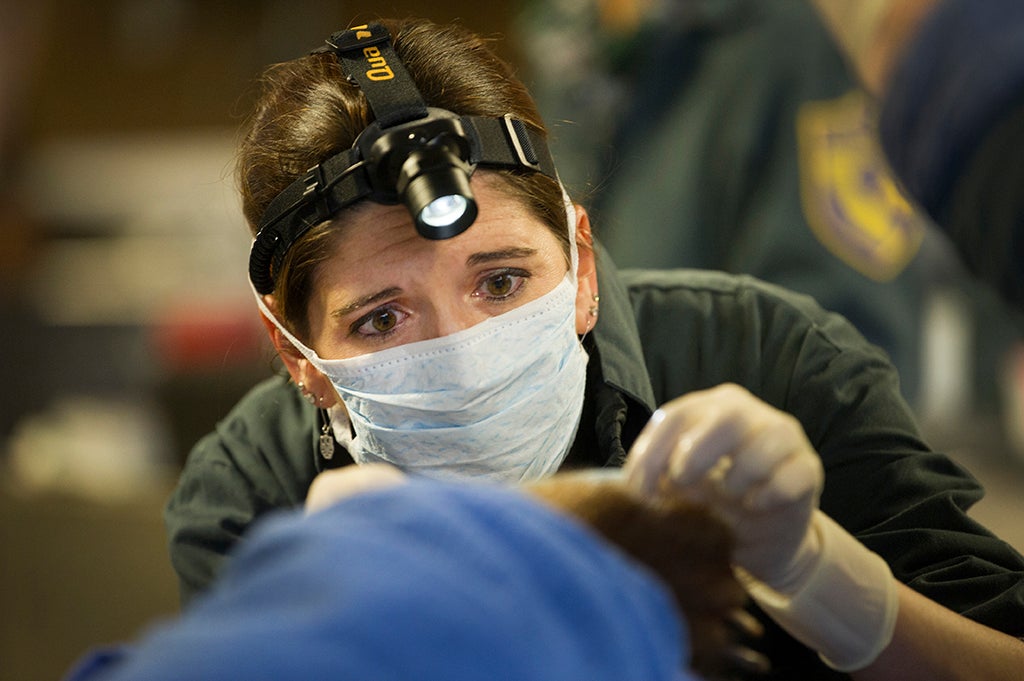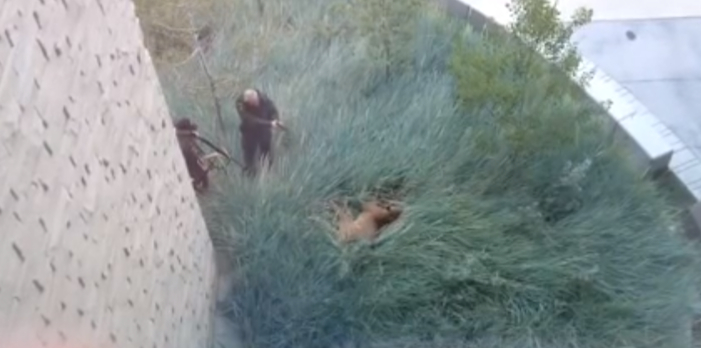In 2017 during wildfires in California, UC Davis veterinarians used a unique treatment — fish skins — to heal severe burn wounds of two bears and a mountain lion club.
The groundbreaking technique was previously used in Brazil on humans but never before on a wild animal.
Jamie Peyton of the UC Davis Wildlife Disaster Network and partners with the California Department of Fish and Wildlife pioneered the technique of suturing tilapia skins to an animal’s paws to act as healing bandages.
Tilapia skins supply collagen, hasten healing and are harmless to the animals if swallowed. The treatment has since been successfully used to treat the burn wounds of wild and domestic animals around the world — from kittens and ponies to kangaroos and koalas.
Two adult female black bears that were burned during the Thomas Fire in Southern California have recuperated and are now back in the wild thanks to the help of University of California, Davis, veterinarians and the California Department of Fish and Wildlife.
The bears, along with a 5-month-old mountain lion, were all brought to the CDFW Investigations Lab in Rancho Cordova for treatment after being found with severe burns from the fires that swept through Santa Barbara and Ventura counties.
Deana Clifford, senior wildlife veterinarian with the CDFW and an assistant clinical professor at the UC Davis School of Veterinary Medicine worked to treat the burns, and enlisted Jamie Peyton, chief of the Integrative Medicine Service at UC Davis Veterinary Medical Teaching Hospital to help with pain management.
Both bears had severe burns on their paws. The younger bear, which was brought to the lab on Dec. 9, had severe third-degree burns on all four paws.

“When I saw the degree of injury that she had and how much pain she was in, as a veterinarian, it just tugs at your heart,” said Peyton, who also serves as associate director for the UC Davis Center for Advancing Pain Relief. “You want to do everything possible to get these animals feeling better. It’s not their fault they were in this horrible fire and they’re in a strange environment and they don’t know what’s going on and they hurt.”
Peyton initially estimated it would take four to six months for the bears’ wounds to heal. Giving them a long time to recover wasn’t an option. The team didn’t want to risk having the bears acclimate to people or captivity. Standard care, which would require frequent bandage changes, would also be difficult with a wild animal. The team also had trouble getting the bears to eat pain medication. Complicating the situation even more, they soon found out that the older bear was pregnant.
“That was a game changer for us, because we knew it wouldn’t be ideal for her to give birth in confinement,” Clifford said. “We aren’t really set up to have a birth at the lab holding facilities, and we knew there was a high probability that she could reject the cub, due to all the stress she was under.”
An innovative solution: Fish skins
Peyton remembered reading about a group in Brazil that had used sterilized tilapia skins to successfully treat burns on humans. While the treatment had never been performed in the United States and never on animals, Peyton decided it was worth trying.
“The high collagen level in the fish skins helps with healing and acts like a matrix,” said Peyton. “It would act as protection and it was pretty inexpensive and available.”
It took Peyton and her team several days to obtain the fish skins and sterilize them in the lab, but the payoff was worth it. Before the fish skins were sutured to the bears, the bears could only sit with their paws off the ground.
“One of the first things that the bear did was stand up after we applied them,” said Peyton. “She was more mobile, which in my mind is a huge success for pain control.”
The bears also received acupuncture, chiropractic care, transcutaneous electrical nerve stimulation (TENS), pulsed electromagnetic field therapy, and cold laser therapy. All of the integrative therapies help with pain control and enhance wound healing by increasing blood and lymphatic flow. The team also worked with UC Davis veterinary pharmacists to create a new burn salve designed to ease the bears’ pain.
Peyton believes all of these therapies played a role in the bears’ healing, but it wasn’t until the tilapia skins were applied that the biggest change occurred. In a matter of weeks, new skin had grown back on the bears’ paw pads.

The younger bear rests in her holding enclosure after her treatment is finished. The outer wrapping on her feet (made of corn husks) will delay her efforts to chew off the tilapia skin bandages underneath. (Photo / California Department of Fish and Wildlife)
“In our view, there was no downside,” said Peyton. The fish skins are even edible, and no reactions to the skins were observed. The mountain lion, which received the same treatment as the bears, ended up eating his.




